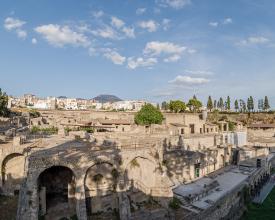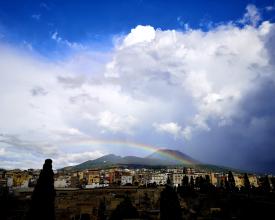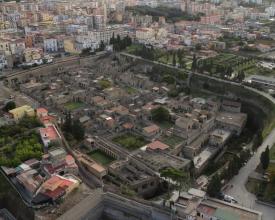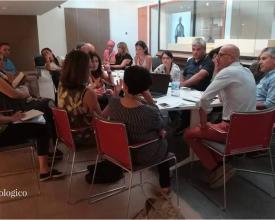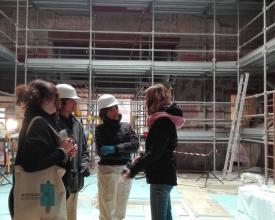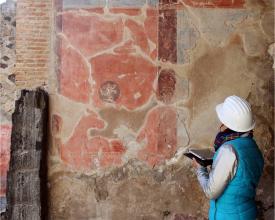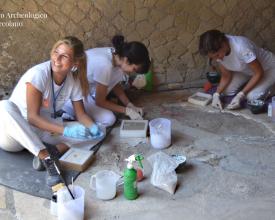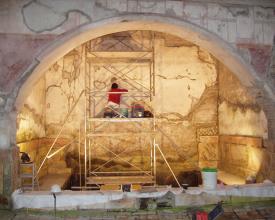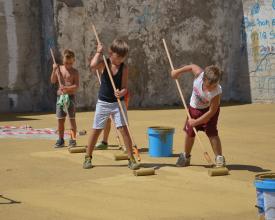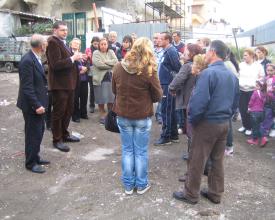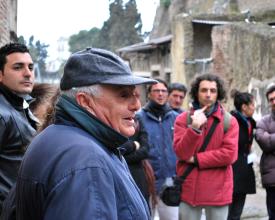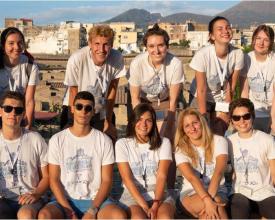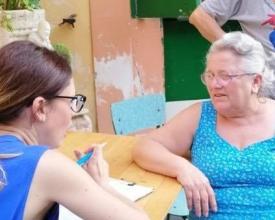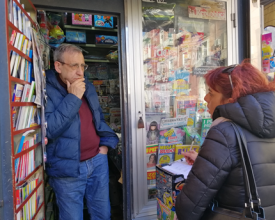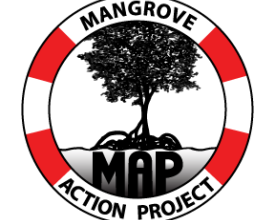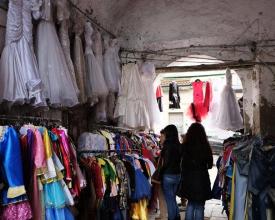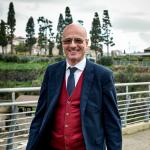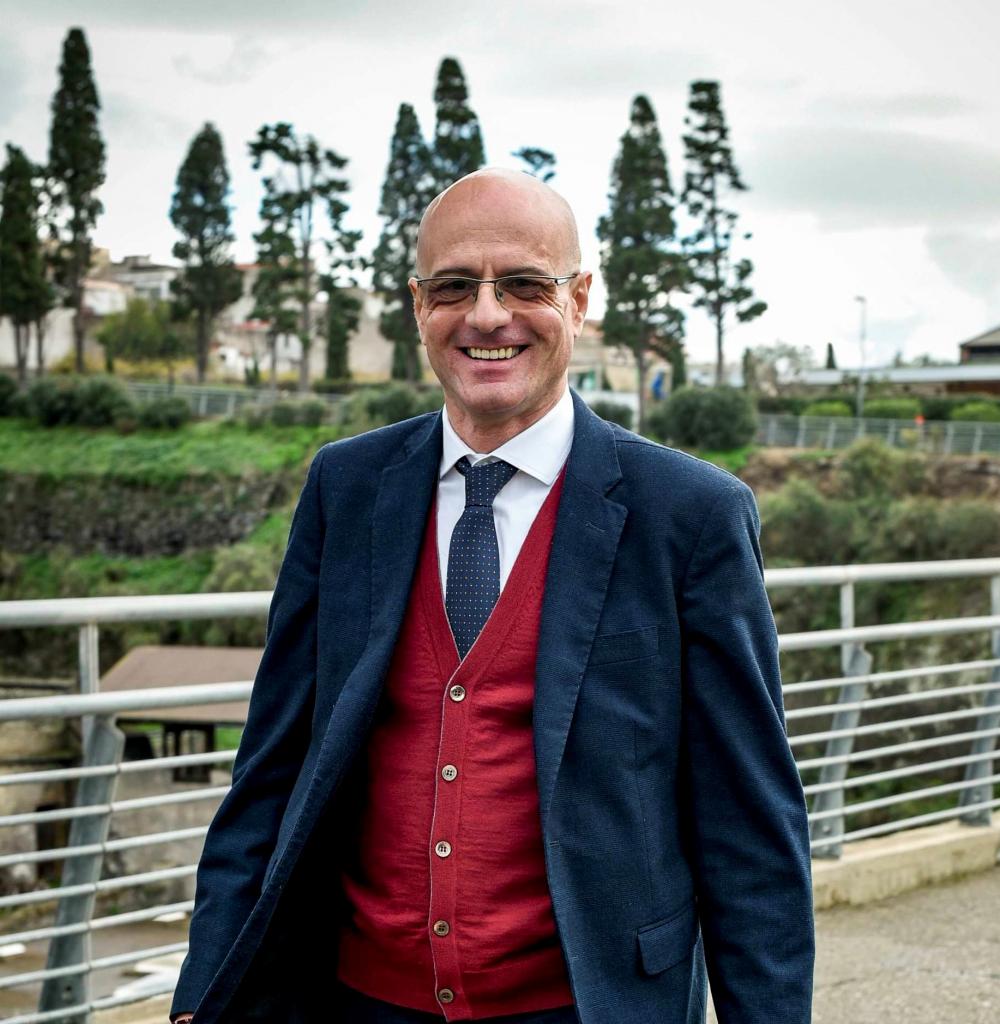
Partenariat pour le bien-être d'Herculanum et de ses communautés
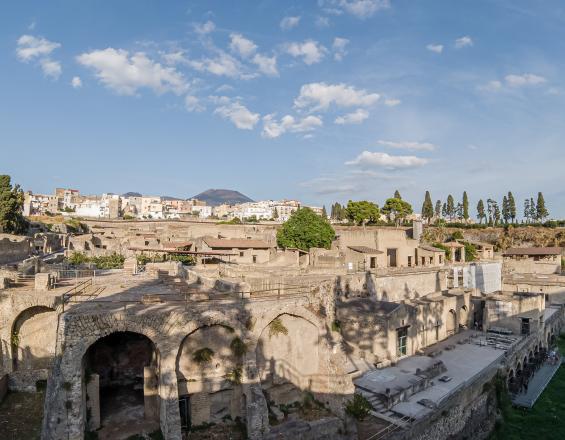
Herculanum était une ville romaine ensevelie par l'éruption du Vésuve en l'an 79. Elle fait désormais partie du bien en série inscrit au patrimoine mondial "Zones archéologiques de Pompéi, Herculanum et Torre Annunziata" et se trouve dans la ville côtière moderne d'Ercolano, l'une des zones les plus densément peuplées d'Italie. Cette solution montre comment un partenariat initié par une fondation philanthropique est devenu un tremplin pour le changement et une coopération plus large au bénéfice du site et de ses communautés. Au fil du temps, ce partenariat public-privé a stimulé des réformes au sein du système du patrimoine public. Celles-ci comprennent la création récente d'une autorité spécialisée dotée d'une plus grande capacité à mettre en place des réseaux de soutien dans et autour du patrimoine d'Ercolano.
Avec un état de conservation nettement amélioré, de nouvelles zones ouvertes au public et un rôle plus dynamique du site dans la vie de la ville moderne, l'expérience de gestion et les approches de conservation de ce site ont encouragé des approches similaires ailleurs.
Contexte
Défis à relever
Culturel/social: Jusqu'aux années 1980, les gardiens, les conservateurs, les équipes d'entretien, etc. étaient généralement des habitants de la région et le site contribuait de manière dynamique au bien-être de la communauté locale. À la fin du XXe siècle, le site était physiquement et visuellement coupé de la communauté locale, qui connaissait des désavantages sociaux extrêmes et des taux de criminalité croissants. Une série de facteurs, dont la demande d'appels d'offres ouverts dans le secteur public, ont accéléré ce divorce.
Environnement: Au début du XXIe siècle, le site était dans un état de délabrement avancé, les deux tiers n'étant pas accessibles au public. La croissance urbaine incontrôlée et le passage à l'agriculture intensive au 20e siècle ont déconnecté le site des autres éléments du patrimoine naturel et culturel du paysage.
L'économie: Le site a souffert de la discontinuité du soutien financier. La région au sens large a souffert de niveaux élevés de pauvreté et de périodes d'inefficacité du gouvernement local. Les taux de chômage sont un indicateur, atteignant récemment 70 % chez les jeunes.
Emplacement
Traiter
Résumé du processus
Le projet de conservation d'Herculanum était à l'origine un modèle public-privé flexible visant à résoudre des problèmes chroniques de conservation et de gestion. Il a ensuite testé des approches susceptibles d'être adoptées à long terme par le partenaire public. Grâce à une équipe opérationnelle présente en permanence sur le site depuis deux décennies, les solutions ont répondu aux besoins spécifiques du site patrimonial et de ses parties prenantes. La collaboration avec les acteurs locaux et nationaux a permis de relier le site archéologique au paysage historique et naturel et de faire participer la communauté locale, les associations, les organisations internationales et d'autres acteurs non liés au patrimoine. En mettant davantage l'accent sur la compréhension des valeurs et l'établissement de liens entre les éléments du lieu patrimonial, on a créé les conditions permettant à Herculanum de contribuer aux aspirations en matière de développement durable et d'obtenir un soutien beaucoup plus large du public en faveur de sa protection.
L'objectif BB1 est de créer les conditions du changement. Les objectifs BB2 et BB3 visent à mettre en place des modèles de conservation et de gestion susceptibles d'assurer la durabilité du patrimoine à long terme. Le BB4 consiste à aller plus loin et à travailler pour permettre au patrimoine de jouer un rôle dynamique dans la société.
Blocs de construction
Partenariat public-privé efficace pour le patrimoine
En réponse à la grave dégradation du site archéologique, un processus de changement a été lancé en 2001 par une fondation philanthropique, le Packard Humanities Institute. Vingt ans plus tard, le partenariat public-privé qui a vu le jour, le projet de conservation d'Herculanum, continue de conserver et d'améliorer l'ancienne Herculanum et ses relations avec la zone environnante, y compris la ville moderne d'Ercolano et la région vésuvienne au sens large. Les activités des partenaires se déroulent aujourd'hui dans le cadre du système de gestion de l'autorité publique chargée du patrimoine et responsable du site, le Parco Archeologico di Ercolano. Le partenariat a également bénéficié de collaborations importantes avec de nombreux autres acteurs locaux, nationaux et internationaux.
Chaque partenaire apporte ses forces particulières à l'initiative : par exemple, le mandat démocratique et l'engagement à long terme de l'autorité publique, ainsi que la réactivité et la vision du partenaire privé. Une équipe de spécialistes italiens de différentes disciplines et des entrepreneurs spécialisés ont travaillé aux côtés des responsables du patrimoine public pour identifier et résoudre les problèmes rencontrés à Herculanum, en renforçant de l'intérieur le système de gestion existant.
Facteurs favorables
Le partenariat public-privé a trouvé un terrain fertile pour démarrer grâce à une première phase d'autonomie de gestion que l'autorité patrimoniale locale a obtenu du ministère central en 1997, ce qui a créé un partenaire public plus réactif et plus flexible. Des résultats encore plus significatifs ont été obtenus depuis la création, en 2016, d'une autorité de gestion dédiée au seul site d'Herculanum.
Au cœur de l'amélioration d'Herculanum au XXIe siècle se trouve l'engagement du partenaire privé en faveur d'un partenariat à long terme comme moyen de parvenir à un changement durable.
Leçon apprise
- Le secteur public peut souffrir d'un manque de ressources intellectuelles, d'un excès d'obstacles administratifs et d'une mauvaise répartition des risques et des responsabilités. L'élément international du partenariat a aidé dans ces domaines, également en augmentant la neutralité et en réduisant l'impact des agendas politiques à court terme.
- Dans un secteur parfois fermé et autoréférentiel, le partenariat public-privé a servi de catalyseur pour renforcer et ouvrir le système de gestion existant à de nouvelles formes de coopération avec divers groupes d'intérêt.
- L'aide extérieure est souvent jugée en fonction de l'ampleur du financement, alors que c'est souvent le paramètre temps qui définit l'efficacité des initiatives multilatérales. Une bonne planification de l'utilisation du soutien à long terme peut garantir des solutions capables de survivre longtemps après la durée de vie d'un partenariat.
- Les retards dans la mise en place d'un cadre juridique permettant au partenariat de s'épanouir semblaient constituer un obstacle. En réalité, le délai de trois ans avant l'action réelle sur le site s'est avéré un avantage pour construire une compréhension mutuelle et consacrer un temps de qualité à la compréhension des besoins du site et du système de gestion.
Approches de conservation et de gestion durables pour les grands sites
En raison de la nature de l'enfouissement d'Herculanum il y a 2000 ans, les fouilles en plein air du début du XXe siècle ont révélé un niveau extraordinaire de préservation de la ville romaine, mais elles ont dû s'accompagner de la stabilisation de ces ruines à plusieurs étages et de la remise en état des routes et des systèmes d'évacuation des eaux. Le site nécessite aujourd'hui la conservation du tissu archéologique, mais aussi de ces interventions de restauration vieillissantes, et ce à l'échelle urbaine.
Cependant, les efforts déployés à Herculanum à la fin du XXe siècle ont abordé le site comme une série d'éléments individuels. Cela s'explique en partie par l'accès limité à l'expertise interdisciplinaire et à des sources de financement régulières - le financement sporadique de projets ponctuels et localisés a prédominé.
Au tournant du millénaire, une nouvelle approche a été adoptée pour cartographier les problèmes de conservation et leurs interdépendances sur l'ensemble du site, et pour agir en conséquence. Les premiers efforts se sont concentrés sur la résolution des situations dans les zones menacées d'effondrement ou présentant des éléments décoratifs vulnérables. Au fil du temps, l'accent a été mis sur des stratégies à long terme visant à réduire les causes de dégradation et à développer des cycles d'entretien à l'échelle du site, soutenus uniquement par l'autorité publique, afin que le site ne revienne pas en arrière. L'objectif global a été atteint puisque ces cycles sont désormais entièrement pris en charge par le partenaire public.
Facteurs favorables
L'évolution du cadre juridique italien en 2004 a permis au partenaire privé de passer directement des contrats pour des travaux de conservation et de "donner" des résultats concrets, au lieu de se contenter d'un soutien financier. Cela a permis au partenariat de constituer une véritable amélioration opérationnelle du système de gestion existant.
D'autres réformes juridiques concernant le patrimoine culturel au cours de la période 2014-2016 ont ensuite renforcé la flexibilité des partenaires publics et leur capacité à répondre aux besoins du site.
Leçon apprise
- L'analyse interdisciplinaire et la prise de décision pour les grands sites patrimoniaux peuvent être améliorées par l'utilisation d'outils de gestion de données dirigés par l'utilisateur. L'intégration d'outils informatiques interdisciplinaires dans la planification, la mise en œuvre et le suivi de la conservation était cruciale pour une plus grande efficacité dans l'utilisation de ressources limitées, qu'elles soient humaines, financières ou intellectuelles.
- Les longs délais disponibles pour le partenariat et la présence tout au long de l'année d'une équipe interdisciplinaire ont permis de développer une compréhension complète et nuancée des besoins du site et de tester de manière approfondie les stratégies à long terme pour y répondre, avant de confier les régimes d'entretien à l'autorité publique chargée du patrimoine.
- Les interventions de restauration étendues et problématiques du 20e siècle sont un défi auquel est confronté un grand nombre de sites du patrimoine bâti pour lesquels un plus grand partage des connaissances est souhaitable.
- La pandémie de Covid-19 a mis en évidence la vulnérabilité financière du modèle institutionnel en l'absence de recettes de billetterie et d'incertitudes quant à la capacité du partenaire public à maintenir à long terme les améliorations apportées à la conservation et à l'entretien des sites.
Le patrimoine, une responsabilité partagée
Au fur et à mesure que le partenariat public-privé améliorait les approches de la conservation, il est apparu clairement que les défis rencontrés sur le site étaient influencés par son contexte plus large. Il était vital de reconnaître la zone vésuvienne et les dynamiques socio-économiques plus larges comme une source d'opportunités, et non de menaces, susceptibles de renforcer la gestion du site. Le patrimoine est de plus en plus considéré comme une responsabilité partagée.
Le Centre Herculanum, une association à but non lucratif fondée par l'autorité chargée du patrimoine, la municipalité et un institut de recherche pour consolider un réseau de partenaires locaux, nationaux et internationaux, a été une initiative clé. Pendant cinq ans, il a mis en œuvre un programme d'activités visant à stimuler de nouveaux types d'implication dans le patrimoine d'Ercolano. La capacité à travailler avec d'autres a été renforcée au sein des institutions et de la société civile par le biais de réseaux de recherche, de projets communautaires et d'une variété d'environnements d'apprentissage.
La confiance des partenaires locaux a créé des conditions inimaginables dix ans plus tôt pour la régénération d'un quartier urbain difficile adjacent au site archéologique connu sous le nom de Via Mare.
Le programme du Centre étant achevé, cette tradition de coopération a été reprise par la nouvelle autorité chargée du patrimoine d'Herculanum, avec le soutien de la fondation Packard et d'autres partenaires.
Facteurs favorables
De nombreuses initiatives, dont le Centre et Via Mare, se sont appuyées sur les premiers efforts des membres de l'équipe du projet de conservation d'Herculanum. Les résultats positifs de la liaison avec les initiatives locales en cours et de l'établissement de passerelles entre des réalités fonctionnant séparément ont commencé à façonner des stratégies à long terme pour la gestion du site et de son environnement.
Depuis 2004, une série de réformes de la législation italienne a permis aux autorités publiques chargées du patrimoine, traditionnellement rigides et fermées, de travailler plus efficacement avec d'autres.
Leçon apprise
-
La création d'un premier partenariat a servi de catalyseur à de nombreux autres, aboutissant à un réseau étendu et autonome. À Ercolano, une partie du panorama dynamique des associations et coopératives locales créées au cours des deux dernières décennies peut être directement liée aux cinq années intensives du Centre Herculanum et aux initiatives prises depuis pour consolider ces progrès. L'accent mis sur les nouvelles formes d'interaction dans les sites patrimoniaux reste essentiel.
-
Le fait de toucher des personnes extérieures au site a permis à Herculanum de bénéficier d'un plus grand soutien politique et social pour sa conservation, d'obtenir des ressources supplémentaires et d'être inclus dans la programmation stratégique.
-
Une institution publique du patrimoine doit avoir dans son mandat le concept de "travail avec les autres", même si cela n'est pas encore pris en compte dans les cadres législatifs et institutionnels. Une institution publique du patrimoine remplit véritablement sa mission en s'appuyant sur les contributions - et les avantages - d'un réseau plus large d'acteurs locaux, nationaux et internationaux.
Créer les conditions d'une gestion participative et fondée sur les valeurs qui soutienne le développement durable
Récemment, un programme de recherche participative mené par le partenaire privé a permis à la nouvelle autorité chargée du patrimoine de promouvoir une gestion du patrimoine véritablement participative et fondée sur les valeurs. Comprendre le patrimoine en termes d'importance attribuée par les uns et les autres peut contribuer à la conservation du site et améliorer la gestion des changements dans le paysage au sens large. La diversité des perceptions et des relations avec le bien du patrimoine mondial et d'autres éléments du patrimoine a été cartographiée, ce qui a permis de faire émerger des liens et des interdépendances précédemment négligés.
L'initiative vise également à identifier la capacité de la société civile, des institutions et des spécialistes locaux du patrimoine à contribuer aux programmes relatifs au patrimoine et va donc au-delà de la cartographie culturelle classique pour comprendre ce qui déclenche un changement positif dans un vaste réseau local.
Les premiers résultats tangibles sont des outils géoréférencés destinés à améliorer la prise de décision en matière de changement et de continuité et à exploiter les capacités locales dans ce processus. L'objectif principal est de saisir tout le potentiel de la contribution du patrimoine au développement durable dans cette région difficile et complexe.
Facteurs favorables
Ce travail est possible grâce à l'adoption d'approches centrées sur l'homme à Herculanum, à plusieurs niveaux, pour les activités et la gestion du site sur une longue période. Il s'agit notamment d'impliquer de multiples parties prenantes dans l'identification des valeurs patrimoniales, qui constituent ensuite la base de la compréhension des liens entre le patrimoine et un paysage plus large. Il s'agit également de donner à Herculanum un rôle dans le soutien des aspirations locales en matière de développement durable, de manière à ce que la communauté locale et le patrimoine lui-même en tirent profit.
Leçon apprise
- Les défis spécifiques de la région vésuvienne avaient déjà conduit l'équipe à considérer intuitivement le succès de la gestion du site en termes sociaux, économiques et environnementaux, mais il est devenu de plus en plus important que les mesures de durabilité dépassent les limites du site.
- Le fait d'envisager Herculanum dans le cadre d'un réseau plus large de personnes et de lieux a permis de jeter les bases de plans à plus long terme pour la conservation et le développement durable.
- Pour que les résultats d'initiatives participatives ambitieuses soient pertinents et le restent dans le temps, il est important de prévoir un long délai pour permettre l'établissement de relations de confiance, condition préalable à tout succès dans ce domaine.
- Il faudra attendre dix à vingt ans pour savoir si l'investissement en cours dans les outils, la recherche, la gestion/le partage des connaissances et la création de réseaux permet d'assurer au patrimoine un rôle plus dynamique dans le développement durable et d'en exploiter les avantages pour les communautés locales et les autres parties prenantes, ainsi que de nouvelles formes de soutien au patrimoine.
Impacts
Social: les initiatives liées au patrimoine ont joué un rôle clé dans la construction de l'inclusion sociale et le renforcement des capacités locales, comme le rôle des acteurs de la communauté locale dans la régénération urbaine à proximité du site. L'ouverture du système de gestion du patrimoine a contribué à (re)créer un consensus et une fierté au sein de la société civile en ce qui concerne le patrimoine mondial, mais aussi d'autres biens patrimoniaux locaux, avec l'émergence de nouvelles formes de consensus démocratique, comme dans le cas du marché historique de Pugliano.
L'économie: Le succès du partenariat public-privé a entraîné la création d'une autorité publique spécialisée dans le patrimoine, rapprochant ainsi la prise de décision des problèmes. Cela a permis de contrôler directement les recettes de billetterie et de donner libre cours à de nouvelles formes de partenariat. L'évolution des mentalités des principaux acteurs a permis d'augmenter les financements et de diversifier les sources de gestion des sites. Les activités laissent également un héritage durable au-delà du site, comme une main-d'œuvre plus qualifiée, de nouveaux domaines d'expertise et l'esprit d'entreprise.
Environnement: la dégradation qui a conduit à la fermeture des deux tiers du site a été résolue, conséquence directe d'une approche de gestion participative plus globale incluant le cadre. Les zones agricoles et urbaines abandonnées autour du site ont été réhabilitées. La gestion stratégique s'appuie de plus en plus sur les interdépendances avec le paysage naturel et culturel au sens large.
Bénéficiaires
Les principaux bénéficiaires sont l'autorité publique responsable du patrimoine d'Herculanum, les autorités locales et les communautés qui vivent et travaillent autour du site. Un réseau plus large de parties intéressées, des chercheurs aux visiteurs, en a également bénéficié.

